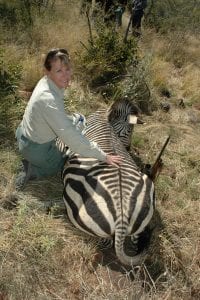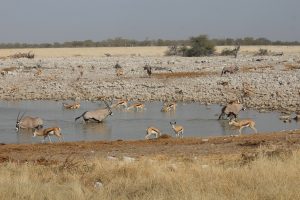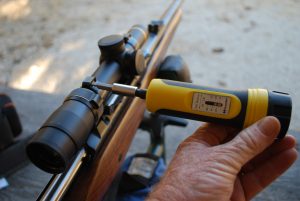Where to hunt “Africa’s whitetail.”
Photo credit: An old harnessed bushbuck with one horn tip broken, taking a drink along a river in Benin. (Photo by Christophe Morio)
On a hunt in Uganda this past March, we spent our last few days hunting sitatunga in riverine papyrus beds, and we were successful on the last evening. On our very last day, we needed to be in Kampala by late afternoon for a midnight departure, but we had time for a morning hunt. Donna wanted a bushbuck, so we headed into mixed thornbush away from the river. Just at full daylight, hardly a half-hour from camp, she and PH Jumbo Moore stalked a big ram on a brushy antheap. It was the second bushbuck they’d stalked, but this one held for a shot.
The ram had heavy 16-inch horns, big for any bushbuck. And this wasn’t any bushbuck; it was a Nile bushbuck, one of the smaller races, so hers was exceptional. I shouldn’t have been surprised. In general, Donna is not a lucky hunter, but she’s been charmed with big bushbucks! I wouldn’t have banked on one that large, certainly not on a one-morning hunt. However, we were in a special place for bushbucks.
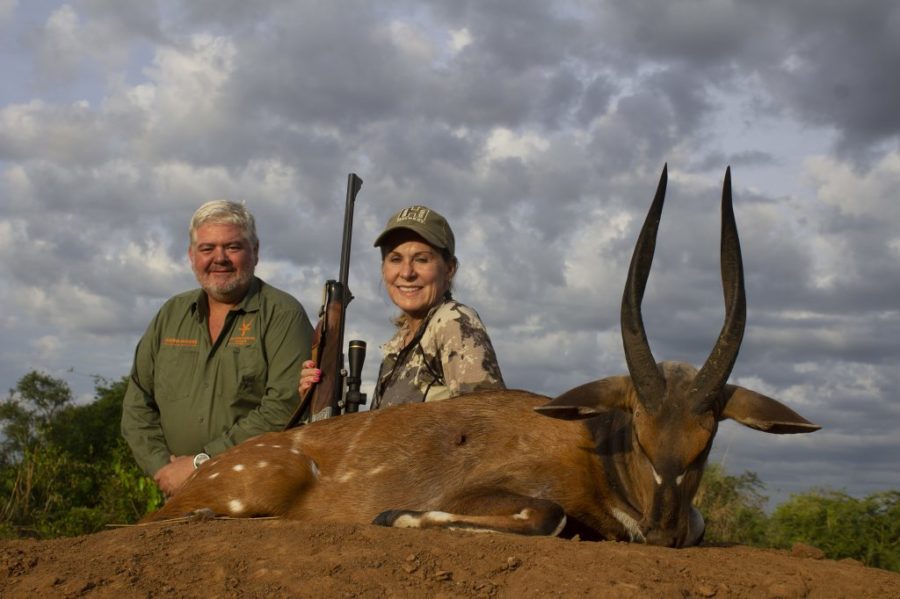
We were on the Kafu River in central Uganda. The wide, shallow river holds huge papyrus beds, ideal sitatunga habitat shared with crocodiles and hippos. Away from the river, small croplands are interspersed with thick cover, and I’ve never seen such a concentration of bushbucks (of any kind). Along the Kafu, bushbucks walk around like goats. You’ll see a few at any time of day, but poke around slowly in early morning or late afternoon, and you’re almost certain to see nice rams.
The bushbuck, Tragelaphus scriptus, is the smallest and most widespread of Africa’s spiral-horned antelopes. I think of them as Africa’s whitetail, and there are many parallels: Both species are crafty and love heavy cover. When threatened, the bushbuck gives a sharp bark, just as final as the whitetail’s alarm snort. Size and color vary confusingly. In the nineteenth century, when every explorer (or wannabe explorer) wanted an animal named after him/her, there were as many as forty races identified. Many are still disputed, but some modern experts reckon something like eight regional groupings is more likely. SCI and Rowland Ward’s record-keeping systems are not in total agreement on number or nomenclature, boiling the bushbucks down to eight and nine races respectively, all by regional grouping. A major difference between the two systems: Rowland Ward classes all bushbucks in South Africa (and adjacent southern Mozambique) as the South African bushbuck, with Chobe bushbuck to the north. SCI splits this into Cape bushbuck along the coast, adding the Limpopo bushbuck in northern South Africa and adjacent Zimbabwe.
Taking one each of all the bushbucks is a Herculean task, and I have not. By SCI’s categories, I’m missing the Abyssinian bushbuck of Ethiopia’s lowlands. By Rowland Ward’s listings, I’m also missing the (disputed) Shoan bushbuck, found only on the southwest edge of Menelik bushbuck range in Ethiopia’s high country, but smaller and with almost no white markings; and the Somalian bushbuck of Somalia’s southern coast, not hunted for many years (current status unknown).
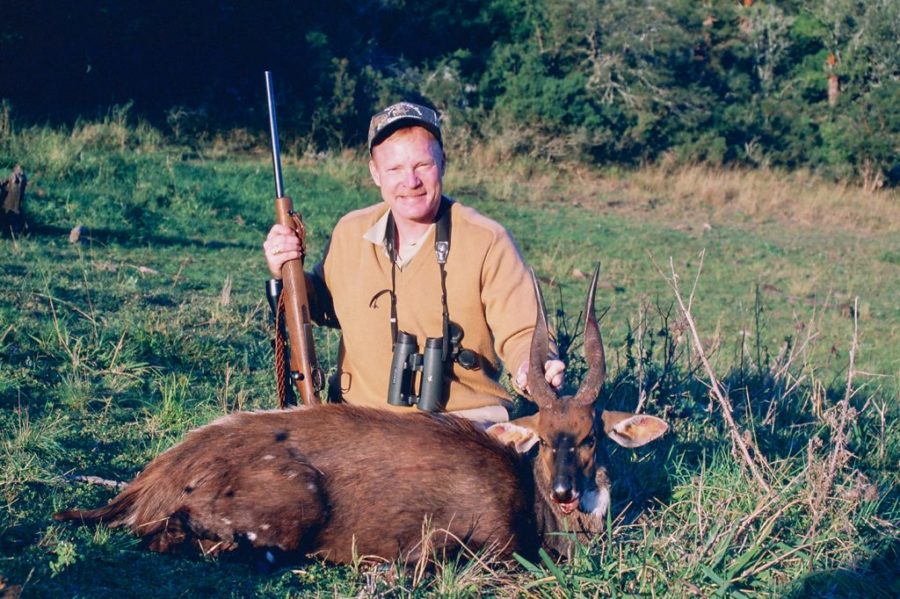
No matter; I like to hunt bushbucks. Rarely is a bushbuck a primary objective of a safari, but trophy fees are low and hunting them is interesting, making them an ideal add-on to any safari where they occur (which is almost everywhere except in desert habitat). They’re crafty, tasty, and gorgeous! Typically, South African (Cape) rams are very dark, as are the Menelik bushbuck. Chobe and Abyssinian bushbucks are usually red while, in my experience, Limpopo and East African bushbucks may be very red or very dark. Most have a white throat patch and a variable patterning of white spots and stripes. The westernmost harnessed bushbuck, found throughout the forest zone, usually has the most brilliant markings, followed by the Nile bushbuck, currently hunted only in Uganda.
Throughout the races, individuals vary in markings (which largely led to the many proposed subspecies). As hunters, we usually don’t shoot bushbucks based on color; we tend to look at horns first: Spiraling gently upwards from thick bases, and usually ending in needle-sharp tips. Anywhere, an older ram with thick, worn horns may be a fine trophy at 12 or 13 inches. A 14-inch bushbuck is always good, and any ram in the 16-inch class is cause for serious celebration. In the old days, Kenya produced the longest-horned bushbucks. My first, up on Mount Kenya, had 18-inch horns, and remains my best. However, almost all of the races, even smaller bushbucks like harnessed and Nile, have produced individuals with outsized horns. It depends on your luck.
In today’s world, the Limpopo drainage probably produces the largest bushbucks, but Masailand’s scattered mountains also produce big rams. Chobe bushbuck in the Zambezi drainage in Zambia and northern Zimbabwe are generally smaller, but seem to grow exceptionally large in coastal Mozambique. The first time I hunted there, at Mahimba north of the Zambezi, I shot a wonderful 16-inch bushbuck. In a three-week period, three other hunters also took bushbucks. Mine was the smallest of the four, and I’m not ashamed of him!

The big Coutadas of the Zambezi Delta, surrounding the Marromeu Reserve, also produce very large Chobe bushbucks. However, unlike most places where I’ve hunted bushbucks, they seem to be generally (and thinly) distributed in the miombo forest, rather than tied to patches of ideal habitat. This makes them difficult to hunt specifically and on purpose. A few years ago, Donna (naturally) got a wonderful bushbuck there, but I never have. In fact, of the twenty-odd antelope varieties in the area, a big Chobe bushbuck is probably the most difficult, and one game quota that the outfitters never completely fill. Even so, that area produces several rams in the upper teens every year. It depends on your luck, and also how much time you spend specifically hunting bushbuck.
Harnessed bushbucks occur literally throughout the forest zone, but are thin on the ground and difficult to hunt in climax forest. I’ve seen them, and heard them bark, but I’ve had much better luck in the terminalia forest (“savannas”) of northern Cameroon and CAR. Benin and Burkina Faso are also excellent for harnessed bushbuck. Neither Donna nor I got one there, but we didn’t hunt them hard enough. You won’t encounter them daily in Central Africa, but you can hunt along thicker riverine growth that “just looks like” bushbuck habitat, and in the course of a week or two you will almost surely have a chance.
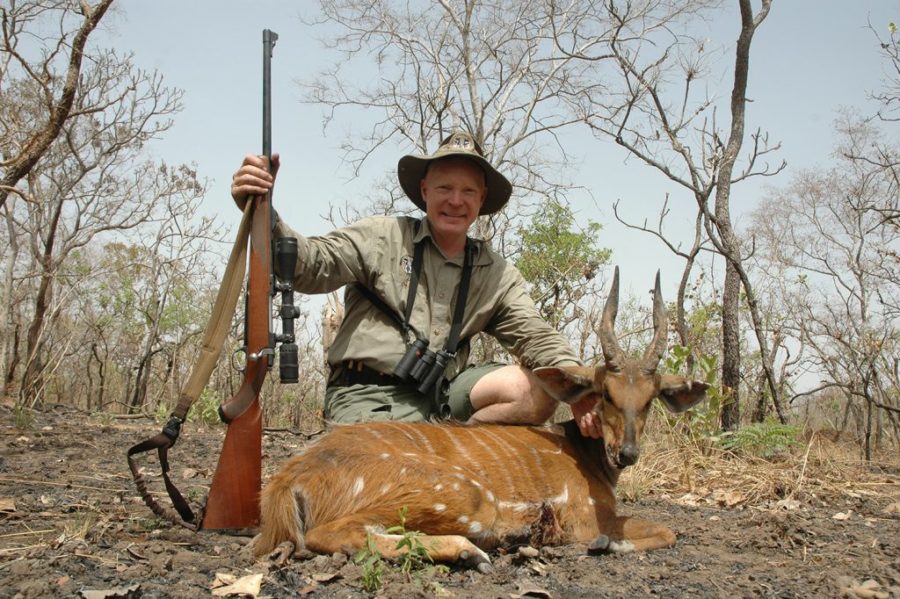
Places like Uganda’s Kafu River, where you can sally forth on almost any given day and expect to encounter a good bushbuck are rare, but not unheard-of. Mount Kenya was certainly like that, and I’m told Tanzania’s Mount Meru is the same. Certainly, there are riverines in the Limpopo drainage, both northern South Africa and southern Zimbabwe, where you can read the habitat, hunt it at the right time, and expect to see good rams.
South Africa’s Eastern Cape is also exceptional for bushbuck, both in the thick coastal thornbush, and in hilly country to the east. Agriculture can also be a key: Again, like whitetails, bushbucks must have heavy cover for security, but they also love “edge” habitat, thriving in the mosaic between farmland and thick bush.
The only time I hunted the nearly black Menelik bushbuck of Ethiopia’s high country, Joe Bishop and I hunted a big farming cooperative near Asela. Our outfitter, Colonel Negussie Eshete, planned just a day and a half between the mountains and the Danakil to hunt this important animal. The country sure didn’t look like bushbuck habitat, just narrow strands of cover along small streams, and big stands of mature eucalyptus with little understory. Negussie fully expected us to take our bushbucks in the allotted time, and we did. Mine was a nice ram, just peering out from behind a stout eucalyptus. As often happened when we hunted together, Bishop got a monster, one of the biggest in recent times. For bushbuck, you always have to be in the right place at the right time. To take a really big bushbuck, you also need a bit of luck!
The views expressed by the editors, authors or users of this linked article are expressly theirs, and do not necessarily reflect the policies or opinions of Dallas Safari Club, its employees, members or assigns. Any concerns about a site user’s post should be addressed appropriately to that person. Any concerns about an advertiser, a user or any content on this site should be addressed to social@dscnortheast.org.

